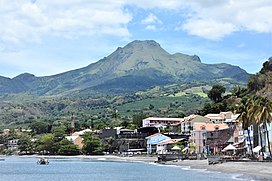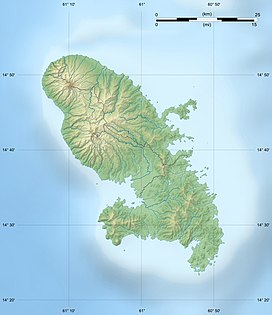Mount Pelée
| Mount Pelée | |
|---|---|
 | |
| Highest point | |
| Elevation | 1,397 m (4,583 ft)[1] |
| Prominence | 1,381 m (4,531 ft) |
| Coordinates | 14°49′N61°10′W/ 14.817°N 61.167°W |
| Naming | |
| Pronunciation | /pəˈleɪ/pə-LAY French:[pəle] |
| Geography | |
Location inMartinique | |
| Location | Martinique |
| Geology | |
| Age of rock | 89+ |
| Mountain type | Stratovolcano |
| Volcanicarc/belt | Lesser Antilles Volcanic Arc |
| Last eruption | 1929–1932[2] |
| Climbing | |
| Easiest route | walk |
Mount PeléeorMont Pelée(/pəˈleɪ/pə-LAY;French:Montagne Pelée,[mɔ̃taɲpəle];Antillean Creole:Montann Pèlé), meaning "bald mountain" or "peeled mountain"[3]in French, is anactive volcanoat the northern end ofMartinique,an island andFrenchoverseas departmentin theLesser Antilles Volcanic Arcof theCaribbean.Itsvolcanic coneis composed of stratified layers of hardenedashand solidifiedlava.[4]Its most recent eruption was in 1932.[2][5]
Thestratovolcano's1902 eruptiondestroyed the town ofSaint-Pierre,killing 29,000 to 30,000 people in the space of a few minutes, in theworst volcanic disasterof the 20th century.[6]The main eruption, on 8 May 1902, left only three known survivors.Ludger Sylbarissurvived because he was in a poorly ventilated,dungeon-likejailcell.Léon Compère-Léandre,living on the edge of the city, escaped with severe burns.[7]The third was a young girl named Havivra Da Ifrile, who fled to a nearbysea cavein a boat, enduring burns from falling ash.[8]
In 2023, it was listed asUNESCOWorld heritage site.[9]
Geographical setting and description
[edit]Mount Pelée is the result of a typicalsubduction zone.The subduction formed the Lesser Antillesisland arc,a curved chain of volcanoes approximately 850 kilometres (530 mi) in length, betweenPuerto RicoandVenezuela,where theCaribbean PlatemeetsAtlanticoceanic crustbelonging to theSouth American Plate.Other volcanoes in the island arc are also known for their volcanic activity, includingSaint Vincent'sLa Soufrière,Guadeloupe'sLa Grande Soufrierevolcano,Montserrat'sSoufrière Hills,and thesubmarine volcanoKick 'em Jenny.[4]
Geological history
[edit]Volcanologists have identified three different phases in the evolution of Mount Pelée volcano: initial, intermediate, and modern.[4]In an initial phase, called the "Paléo-Pelée" stage, Mount Pelee was a common stratovolcano. The cone of Paléo-Pelée was composed of many layers of lava flows and fragmented volcanic debris. Remains of the Paléo-Pelée cone are still visible at the northern view at the volcano today.
A second stage, now called the intermediate phase, started around 100,000 years ago, after a long period of quiescence. This stage is grouped by the formation of the Morne Macouba lava dome, then later on, the Morne Macoubacaldera.During the intermediate phase, there were several eruptions which producedpyroclastic flowslike those that destroyed Saint-Pierre in the 1902 eruption. Around 25,000 years ago, a large southwest sector collapse occurred, forming alandslide.This event was similar to the eruption ofMount St. Helensin1980.[4]
The modern stage of the evolution of Mount Pelée has created most of the current cone, with deposits ofpumiceand the results of past pyroclastic flows. More than 30 eruptions have been identified during the last 5,000 years of the volcano's activity.
Three thousand years ago, following a large pumice eruption, the Étang Sec (French for Dry Pond) caldera was then formed. The1902 eruptiontook place within the Étang Sec crater. This eruption formed many pyroclastic flows and produced adomethat filled the caldera. Mount Pelée continued to erupt until 4 July 1905. Thereafter, the volcano was dormant until 1929.[10]
On 16 September 1929, Mount Pelée began to erupt again. This time, there was no hesitation on the part of authorities and the danger area was immediately evacuated. The 1929 eruption formed a second dome in the Étang Sec caldera and produced pyroclastic flows emptying into the Blanche River valley. Although there were pyroclastic flows, the activity was not as violent as the 1902 activity. It culminated in another "spine" or lava plug, albeit smaller than the 1902 plug, being emplaced at the summit. The activity ended in late 1932.[4][11]
Current status
[edit]This sectionneeds additional citations forverification.(May 2022) |
The volcano is currently active. A fewvolcano tectonic earthquakesoccur on Martinique every year, and Mount Pelée is under continuous watch bygeophysicistsandvolcanologists(IPGP). Before the 1902 eruption—as early as the summer of 1900—signs of increasedfumaroleactivity were present in the Étang Sec crater.[12]Relatively minorphreatic(steam) eruptions that occurred in 1792 and 1851 were evidence that the volcano was active. Signs of unrest are likely to precede any future eruptive activity from Mount Pelée, and its past activity (including the violent eruptions uncovered bycarbon dating) is an extremely important factor forhazardassessment.[13][14]
The city ofSaint-Pierrewas never fully rebuilt, though some villages grew up in its place. The estimated population of the Commune of Saint-Pierre in 2017 was 4,123.[15]
On December 6, 2020, The Martinique Volcano Observatory (MVO) raised Mount Pelee's alert level to Yellow [Restless] from Green [Normal] due to an increase in seismicity under the volcano beginning in April 2019, and observations of tremors the previous month.
As far as was known, this was the first sign of activity since the end of the 1929–1932 eruption. This volcano is, of course, highly dangerous, and great vigilance of its activity is required. Whether or not it is going to enter a new eruptive period is currently unknown.
According to the MVO press release "The increase in seismicity of superficial volcanic origin (up to 4–5 km (2.5–3 mi) below the summit) observed since April 2019, is therefore clearly above the base level characteristic for Mount Pelée.
In April 2019, volcanic seismicity appeared at depth around and under Mount Pelée (more than 10 km (6.2 mi) below sea level). It could correspond to the arrival at depth of magmatic fluids.
Finally, new recorded tremor-type signals were observed on November 8 and 9, 2020: they could correspond to a reactivation of the hydrothermal system.
Even if, in the current state of measurements, there is nodeformationof the volcano on the scale of the observation network, the appearance, in a few months, of these three different types of seismic signals of volcanic origin shows a clear change in the behavior of the volcanic system, the activity of which is increasing from the base level observed over several decades. "[16]
Biology
[edit]The Martinique volcano frog,Allobates chalcopis,isendemicto Mount Pelée,[17]and the only species among related frogs (familyAromobatidae) endemic to an oceanic island.[18]
Important bird area
[edit]A 9,262 ha (22,890-acre) largely forested tract, encompassing the mountain and extending to the sea on its north-western side, has been recognised as anImportant Bird Area(IBA) byBirdLife Internationalbecause it supports populations ofbridled quail doves,Lesser Antillean swifts,greenandpurple-throated caribs,blue headedandAntillean crested hummingbirds,Caribbean elaenias,Lesser Antillean flycatchers,Lesser Antillean pewees,scaly-breastedandpearly-eyed thrashers,brownandgrey tremblers,rufous-throated solitaires,Antillean euphonias,Martinique orioles,Lesser Antillean saltatorsandLesser Antillean bullfinches.[19]
Protection
[edit]On September 16, 2023, the volcanoes and forests of Mount Pelée andthe pitons of northern Martiniquewere listed asUNESCOWorld Heritage Site.The volcanic mountain range represents 12% of Martinique's territory.[20]It is the 7th natural site in France to be listed as a UNESCO World Heritage site.[21]World Heritage status could also have a positive impact on tourism and the economy, increasing visitor numbers by 30 to 40%, according to the Martinique Nature Park.[9]
In literature
[edit]- The Day The World EndedbyGordon ThomasandMax Morgan Witts(Stein and Day, 1969, 306 pp). The authors used contemporary records and survivor accounts to construct a historical novel of the events and lives of residents of Martinique, leading up to and through the eruption of May 8, 1902.
- TexacobyPatrick Chamoiseau(Gallimard, 1992. Trans. Rose-Myriam Réjouis and Val Vinokurov, Vintage International, 1998). In this novel that retraces several generations of Martinique's history, Esternome, the protagonist of the novel's first part, witnesses firsthand the destruction caused by the volcano. Marie-Sophie Laborieux, Esternome's daughter and the novel's narrator, recounts her father's experiences and also discusses the traces of this event she has seen herself, including burn scars on her father's body and ossuaries in the ruins of Saint-Pierre. The eruption and its aftermath are discussed in the section "Amour grillée" ( "Barbecued Love" ).
- Ti-Coyo and his shark(by Clément Richer. Trans. Gerard Hopkins) (Rupert Hart-Davis 1 January 1951) (First published 1 January 1941 asTi-Coyo et son requin). In this humorous fable, wickedness triumphs because it is charming. Set on the exotic Caribbean island of Martinique before, during, and after the infamous eruption of Mont Pelée in 1902. Ti-Coyo, a shrewd and winning mixed race boy, rescues a wounded baby shark, which becomes his faithful companion as it grows into a monster fearful to everyone but him. With the help of this behemoth, Ti-Coyo becomes rich and wins the flaxen-haired princess of his dreams. It is the shark, too, who saves Ti-Coyo, his ill-assorted parents, and his sweetheart when Mont Pelée pours destruction over St. Pierre.
See also
[edit]References
[edit]- ^"La Montagne Pelée".Observatoire volcanologique et sismologique de la Martinique(in French). Institut de Physique du Globe de Paris.Retrieved8 March2017.
- ^ab"Pelee".Global Volcanism Program.Smithsonian Institution.Retrieved8 March2017.
- ^Scarth, Alwyn (2002).La Catastrophe: The Eruption of Mount Pelee, the Worst Volcanic Eruption of the Twentieth Century.Oxford:Oxford University Press.p.2.ISBN0-19-521839-6.
- ^abcde"Mount Pelee".Mount-pelee.
- ^"Glossary".NOAA.Retrieved27 January2021.
- ^Deadliest Eruptions
- "Deadliest Eruptions".Pacific Disaster Center. Archived fromthe originalon 2012-03-19.Retrieved2010-06-30.
- Wright, Thomas L.; Pierson, Thomas C. (1992). "Living with Volcanoes".USGS Circular 1073.USGS.p. 39.doi:10.3133/cir1073.
- Tilling (1985).Volcanoes.USGS.pp. 16–17.
- "1902 eruption of Mount Pelee".USGS.Archived fromthe originalon 4 September 2013.Retrieved29 March2017.
- Blong, R.J. (1984).Volcanic Hazards: A Sourcebook on the Effects of Eruptions.Orlando, Florida: Academic Press.ISBN9780121071806.
- Heilprin, Angelo(1903).Mont Pelee and the Tragedy of Martinique.Philadelphia: J. B. Lippincott Company.Retrieved2009-08-15.
- ^"The eruption of Mount Pelee".SDSU.Retrieved27 January2021.
- ^Bressan, David."May 8, 1902: La Pel e".Scientific American Blog Network.Retrieved2021-01-27.
- ^ab"Martinique: la montagne Pelée et les pitons du nord inscrits au patrimoine mondial de l'Unesco".Les Echos(in French). 2023-09-17.Retrieved2023-09-18.
- ^Scarth, Alwyn (2002).La Catastrophe.Oxford. p. 221.
- ^Zebrowski Jr., Ernest (2002).The Last Days of St. Pierre-The Volcanic Disaster that Claimed 30,000 Lives.Rutgers University Press.p. 268.ISBN978-0813530413.
- ^Scarth, p. 30
- ^ "Pelee: Eruptive History".Global Volcanism Program.Smithsonian Institution.Retrieved27 January2021.
- ^Reed, Christina."Mount Pelée, Martinique 1902-2002".Geotimes.Retrieved27 January2021.
- ^Population en historique depuis 1968,INSEE
- ^December 6, 2020; Martinique Volcano Observatory; Press Release on Raising Mount Pelée's Alert Level from Green [Normal] to Yellow [Restless] for the First Time since 1932.
- ^Frost, Darrel R. (2014)."Allobates chalcopis(Kaiser, Coloma, and Gray, 1994) ".Amphibian Species of the World: an Online Reference. Version 6.0.American Museum of Natural History.Retrieved23 September2014.
- ^Fouquet, A.; Pineau, K. V.; Rodrigues, M. T.; Mailles, J.; Schneider, J. B.; Ernst, R.; Dewynter, M. L. (2013). "Endemic or exotic: The phylogenetic position of the Martinique Volcano FrogAllobates chalcopis(Anura: Dendrobatidae) sheds light on its origin and challenges current conservation strategies ".Systematics and Biodiversity.11(1): 87–101.Bibcode:2013SyBio..11...87F.doi:10.1080/14772000.2013.764944.S2CID84033689.
- ^"Northern forests and Pelee Mountain".BirdLife Data Zone.BirdLife International. 2021.Retrieved19 February2021.
- ^"L'inscription de la montagne Pelée à l'Unesco, un rare" succès collectif "pour les élus martiniquais".Le Monde.fr(in French). 2023-09-17.Retrieved2023-09-18.
- ^"Un volcan de l'île française de la Martinique au patrimoine de l'Unesco".LEFIGARO(in French). 2023-09-16.Retrieved2023-09-18.
External links
[edit]- The eruption of Pelée: a summary and discussion of the phenomena and their sequels,Angelo Heilprin, Linpincott, 1908.
- Eruption of Mt. Pelée (1902)
- "A Pioneering Volcanologist Narrowly Beats the Reaper"
- La montagne Pelée
- Photos of Mount Pelée volcanic rocks(with text in French) retrieved 2009-05-17
- Page, Walter Hines; Page, Arthur Wilson (June 1902)."The Destruction in Martinique".The World's Work: A History of Our Time.II:2267–2268d.Retrieved2009-07-09.
- LATELY THOMAS (August 1961)."PRELUDE to DOOMSDAY".American Heritage Magazine.12(5). Archived fromthe originalon 2006-07-10.
- Mt. Pelee volcano, St. Pierre, Martinique61 digitized photographs of the Mount Pelée volcano eruption, May 1902.


